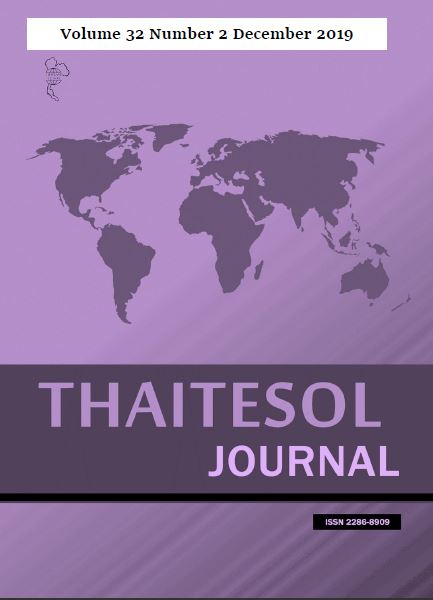Reaffirming a Preference for English Loanwords by Japanese Learners
Main Article Content
Abstract
This non-experimental study gauged the English lexical preferences of 545 native Japanese university students. Specifically, this univariate design collated the frequency of English loanword selection in preference to non-borrowed lexical items. A major focus of the study design was instrument validity, addressing the flaws of two previous studies (Brown, 1995; Small, 2002). With keen attention to vocabulary level, the Genius English-Japanese dictionary 5th edition (Minamide, 2014) facilitated the compilation of an initial, sizeable loanword corpus. Subsequent meticulous corpus revisions provided the lexical content for an instrument featuring loanword vocabulary options. The research instrument comprised 50 brief sentences, each with four valid lexical items in a multiple choice format. Thirty sentences included the choice of one English loanword. The combined frequency of loanword selection from an initial study (n = 283) and a replicated study (n = 262) (N = 545) showed an overall relative frequency average of 0.42. Chi-square analyses of the data comparing both studies indicated that differences in lexical selection were significant at p<.05 for 15 of the sentences with loanwords. Some of the limitations of working with nominal data are highlighted. The use of loanwords by native Japanese speakers can impede effective communication in English because they are not always an appropriate lexical choice. To help minimise perceived and pragmatic failure when communicating, Japanese need to be aware of the pitfalls of using loanwords and improve their English proficiency by increasing their lexical range and flexibility.
Article Details
Materials in THAITESOL JOURNAL may be photocopied for educational purposes. Under no circumstances may any part of this journal be photocopied for commercial purposes.
References
prototypes. In P. J. L. Arnaud & H. Béjoint (Eds.), Vocabulary and applied
linguistics (pp. 71-84). London: Palgrave Macmillan.
Brown, J. B. (1995). Is gairaigo English? The Internet TESL Journal, 1(2). Retrieved from
http://iteslj.org/Articles/Brown-Gairaigo/
Haladyna, T. M. (2004). MC formats. In Developing and validating multiple-choice test
items (pp. 67-96). New York, NY: Routledge.
Haladyna, T. M., & Downing, S. M. (1989). Validity of a taxonomy of multiple-choice item-
writing rules. Applied Measurement in Education, 2(1), 51-78.
Haladyna, T. M., Downing, S. M., & Rodriguez, M. C. (2002). A review of multiple-choice
item-writing guidelines for classroom assessment. Applied Measurement in
Education, 15(3), 309-333. https://doi.org/10.1207/S15324818AME1503_5
Kay, G. (1995). English loanwords in Japanese. World Englishes, 14(1), 67-76. Retrieved
from http://www.csun.edu/~Bashforth/301_PDF/301_P_P
/EnglishLoanWordsJapanese.pdf
Minamide, K. (Ed.). (2014). Genius English–Japanese dictionary. (5th ed.). Tokyo:
Taishukan.
Moreno, R., Martínez, R. J., & Muñiz, J. (2015). Guidelines based on validity criteria for the
development of multiple choice items. Psicothema, 27(4), 388-394.
Price, P. C., Jhangiani, R, Chiang, I. C. A., Leighton, D. C. & Cuttler, C. (2017).
Constructing Surveys. In Research methods in psychology (3rd ed.). Retrieved
from https://opentext.wsu.edu/carriecuttler/chapter/7-2-constructing-surveys/
Rebuck, M. (2002). The function of English loanwords in Japanese. NUCB JLCC, 4(1), 53-
64. Retrieved from https://www.nucba.ac.jp/themes/s_cic@cic@nucba/pdf/njlcc041
/06REBUCK.PDF
Schuwirth, L. W. T., Van der Vleuten, C. P. M., & Donkers, H. H. L. M. (1996). A closer
look at cueing effects in multiple‐choice questions. Medical Education, 30(1), 44-49.
Retrieved from https://www.ncbi.nlm.nih.gov/pubmed/8736188
Small, L. (2002). Defining a preference for English loan words and their focus within a
lexical syllabus. Fukuoka University Language Education and Research Centre Journal,
1, 89-101.
Wilhelm, K. (2008). Test of homogeneity, chi-square. Encyclopedia of Public Health.
Dordrecht, Netherlands: Springer. Retrieved from https://link.springer.com
/referenceworkentry/10.1007%2F978-1-4020-5614-7_3475
Zipgrade LLC. (2019). Zipgrade.com [Mobile application software]. Retrieved from
http://itunes.apple.com


